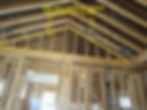Every new home should be built to comply with the current building and energy codes, unfortunately, many new homes built in the greater Louisville area and especially those out in the remote country areas simply do not comply. Many new construction projects don’t get inspected correctly (or at all) and building codes are often not enforced as written.
Building Inspectors' Discretion
The reality is that each building inspector can interpret the codes differently and therefore they can enforce them differently (or not at all), and ultimately that is why new homes don't pass energy codes. However, when a HERS Rater is hired to inspect a new home, part of their job is to verify that the house meets or exceeds energy code requirements. The HERS Rater is hired by the builder or homeowner directly, and is taking the legal responsibility to ensure each new home they inspect will be comfortable, healthy, and efficient, per the code requirements. Building codes exist for many beneficial reasons, not only life-safety reasons, and it’s important that new homes are built to meet or exceed these standards.
Why Do Building Energy Codes Exist?
Building codes have been put in place to ensure that first and foremost, homes are safe for the occupants. This means everything from correct framing for structural integrity to proper installation of electric, plumbing, and HVAC systems. In addition, the International Energy Conservation Code (IECC) has been established to provide requirements that ensure new homes are energy-efficient, healthy, and comfortable.
In Kentucky the building/energy code usually gets updated on 3-6 year cycles, while Indiana’s energy code was updated in 2018. In 2012 Kentucky adopted a slightly different version of the 2009 IECC as their energy code for new residential construction and it has not been updated since (11 years and counting!). Indiana uses a version of the 2015 IECC as of 2023.
What Things are Building Inspectors Missing?
Unfortunately in our area, if a new home isn’t having a HERS Rating (Home Energy Rating Score) performed on it, it is highly unlikely that it complies with the energy code. Many basement walls, for example, aren’t insulated to at least two feet below exterior grade, and this is often overlooked. The requirement to install air-barriers over insulation on walls that face attic space is rarely enforced. Many other issues are related to the way the house is framed, especially when there are vaulted or “tray” ceilings that create changes in ceiling height. These framing issues can make interior wall cavities “open” to the attic spaces above, which creates excessive air-leakage and heat loss.

Testing for Duct-leakage
Perhaps one of the most important energy code requirements that needs to be enforced is pressure-testing ductwork for leaks - when the ducts are located outside the “conditioned space” of the home. For example, if your house is built on a “slab foundation” and the ductwork is up in the attic, then it must be tested for leaks. Or if your house is built on a crawlspace with vents in the foundation walls, then it must be tested. Sadly, this test is still not enforced consistently across Kentucky, even though it’s been required for over 11 years now!
In Kentucky any qualified company testing ductwork must complete a Duct Test Verification (DTV) form. A qualified company is one with the proper equipment, training, and experience needed to conduct duct-leakage testing, and this is typically a HERS Rater or a HVAC contractor. This DTV form has to be submitted to the builder and building inspector, regardless of whether the home gets a HERS rating, but unfortunately many building inspectors still do not ask for this form and furthermore don’t understand how the test works or even who is qualified to do them!

Energy Code Compliance Labels
One of the most basic requirements of the energy code that is still not enforced correctly is having a code compliance sticker completed and placed on the electric panel once the house is complete and actually passes the energy code requirements. This sticker must include all the insulation values throughout the home (R-values), the windows & door performance data (U-factors), heating & cooling system efficiency ratings, water heater efficiency, and last, but not least - the air-leakage and duct-leakage rates as tested.
Typically only the builder or HERS Rater would have knowledge of all the things that are required to be completed on the sticker. Unfortunately, there are several insulation companies in the area that have created their own versions of this sticker that do not include everything required, and most of the time you’ll find that these stickers are only partially filled-out, because the insulation contractor has no idea what the other requirements are. Building inspectors who let these partially-completed stickers pass as “proof” that the houses comply with the energy code are doing the homeowners a big disservice, as their new home will not be as comfortable and efficient as it should be.

Building Performance Ensures Your Home Meets Energy Code
The team at Building Performance are your local energy code experts. Our team knows all the requirements to make homes in Kentucky and Indiana pass code and help make them more comfortable, healthy, and energy-efficient. Hire us to make sure your new home is up to code and will be as comfortable and efficient as possible!